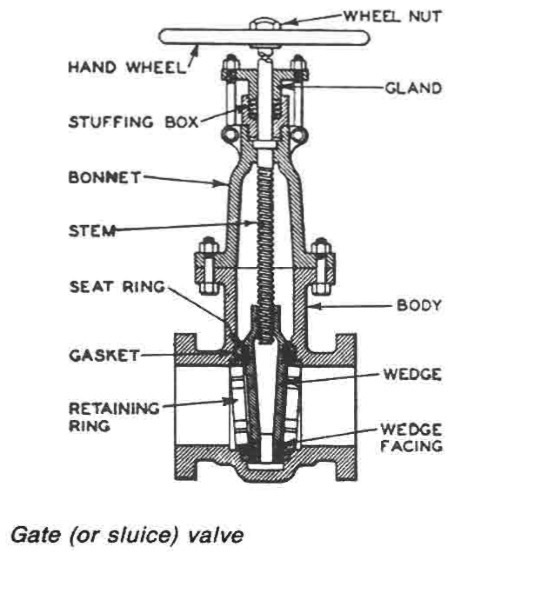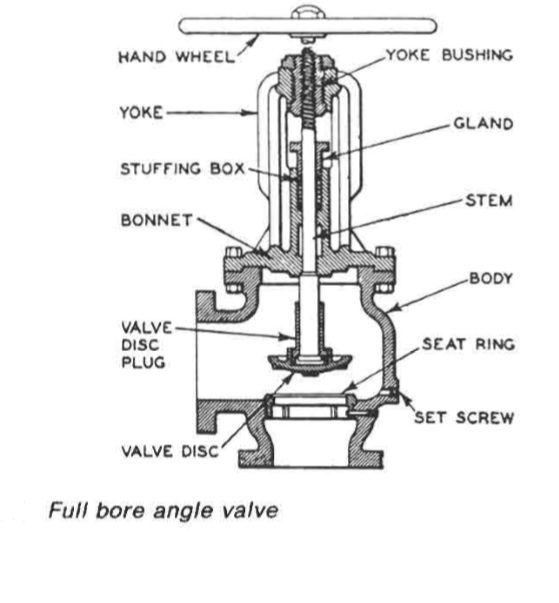
Home page||Valves & pipelines ||
Gate valves for Ship service systems
Valves are designed to control or interrupt flow. This is done in valves by lowering, raising or rotating a disc in relation to a seating surface or by controlling the movement of a ball.
Gate valves
Unlike the globe valve, gate (or sluice) valves (Figure 1) give full bore flow without change of direction. The valve disc known appropriately as a gate, is moved at right angles into the flow by a screwed spindle working in a nut. It rests when closed, between circular openings furnished with seats. Valves and seats may be tapered or parallel on their facing sides. Such a valve is not suitable to partially open operation since wire-drawing of the seat will occur.

Figure 1: Gate (or sluice) valve
The bonnets of these valves are frequently of cast iron and care should be taken when overhauling. To ensure tightness, some parallel gates are fitted with twin discs, dimensioned similarly to the chest seats but pressed against the seats by a spring when closed. Where change of direction is required, a full bore angle valve (Figure 2) may be used.

Figure 2:Full bore angle valve
Valve actuators
A variety of valve actuators to control the opening and closing of globe, gate and butterfly valves are available. In some types an electric motor, fitted with limit switches is used to turn a threaded stem through a yoke, purely substituting the action of a handwheel.
Most remotely operated valves have pneumatic or hydraulic actuators. These give linear motion to a piston which for a globe or gate valve moves the valve stem axially up or down. The globe valve disc may be given a slight turn on landing to clean the seat. The piston actuator for a butterfly valve rotates the valve disc through 90° directly or through a scroll arrangement (Figure below )

Figure :Pneumatic butterfly valve actuator showing scroll cam arrangement
Summarized below some of the basic procedure of machinery valves & pipeline systems :
- Valves & pipeline materials corrosion & erosion
Galvanic corrosion is a major challenge for any pipes which carry sea water. Rust is a particular corrosion problem for steel pipes exposed to contact with sea water or moisture generally and air. Pipe runs along tank tops or on deck, are examples of the latter. Steel pipes in these areas require external as well as internal protection.....
- valves-&-pipelines-strength-of-materials
The strength of materials used for pipes and fittings must be adequate for the
system pressures and possible over-pressures. Pipelines and valves, for
example, used to carry and control the flow of high temperature, high pressure
steam must obviously be made to very exacting specifications by approved
manufacturers.....
- Valves & pipelines-system cleaning & draining
It is often found, in new ships, that the bilges and bilge systems have not been
thoroughly cleaned with the result that wood, nuts, bolts, rags and other debris
are found inside valves and pipes after initial bilge pumping. These choke the
valve-chests and prevent the valves from being properly closed. They also
block strainers. ....
- Expansion arrangements
Provision must be made in pipe systems to accommodate changes in length due to change of temperature, and so prevent undue stress or distortion as pipes expand or contract.....
- Valves & cocks
Cocks and valves are designed to control or interrupt flow. This is done in cocks by rotating the plug, and in valves by lowering, raising or rotating a disc in relation to a seating surface or by controlling the movement of a ball. ...
- Butterfly valves
A butterfly valve consists basically of a disc pivoted across the bore of a ring body having the same radial dimensions as the pipe in which it is fitted.....
- Gate valves
Unlike the globe valve, gate (or sluice) valves give full bore flow without change of direction. The valve disc known appropriately as a gate,....
- Globe valves
The globe valve has a bulbous body, housing a valve seat and screw down plug or disc arranged at right angles to the axis of the pipe....
- Relief valves
Excess pressure is eased by a relief valve . This consists of a disc held closed by a spring loaded stem. The compression on the spring can be adjusted so that the valve opens at the desired pressure. ....
- Valves traps
A steam trap is a special type of valve which prevents the passage of steam but allows condensate through. It works automatically and is used in steam heating lines to drain condensate without passing any steam. ....
- Flap valves & valve chest
Scupper pipes from accommodation spaces are fitted with non-return valves. Those scuppers from spaces below the bulkhead deck, are required to be fitted with non-return valves which can be positively closed from above the bulkhead deck or, if this is not practical, with two non-return valves.....
- Quick closingvalves
Fuel oil service and some other tanks must be fitted with valves that can be closed rapidly and remotely in the event of an emergency such as fire. Wire operated valves are commonly fitted,....
- Strainers & filters
The term strainer is sometimes used specifically for a simple device made up with a single layer of coarse gauze, a very coarse wire mesh or a drilled or perforated plate. ...
Home page||Cooling ||Machinery||Services ||Valves ||Pumps ||Auxiliary Power ||Propeller shaft ||Steering gears ||Ship stabilizers||Refrigeration||Air conditioning ||Deck machinery||Fire protection||Ship design
||Home ||
General Cargo Ship.com provide information on cargo ships various machinery systems -handling procedures, on board safety measures and some basic knowledge of cargo ships that might be useful for people working on board and those who working in the terminal. For any remarks please
Contact us
Copyright © 2010-2016 General Cargo Ship.com All rights reserved.
Terms and conditions of use
Read our privacy policy|| Home page||


